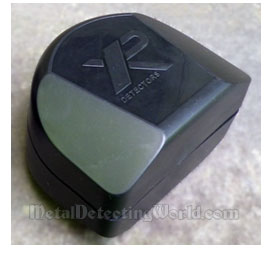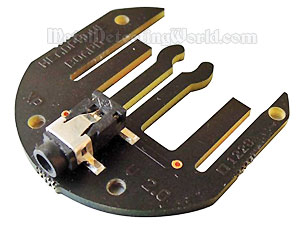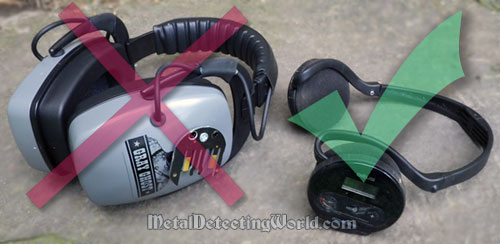Field-Testing DetectorPro Grey Ghost Wireless Headphones, page 5
(...CONTINUED from Previous Page)
Grey Ghost Headphones for XP Deus vs. XP WS4 Ear-Clip Headset
While thinking over this part of my review, I decided to base my comparison of two headsets - wireless Grey Ghost and XP WS4, on my personal impressions and thoughts that I had acquired during field-testing the wireless Grey Ghost headphones and from my long-time usage of the XP WS4 headset.

XP Storage Case for WS4 Headphones
1) Audio with Muffled, Bass Sounds VS. Audio with Sharp, Distinct Sounds
The XP WS4 headphones are designed to produce sharp tones without bass; thus, allowing a Deus user to utilize two key features - Tonal Discrimination and Reactivity, to maximum effect. Any headphones with audio characteristics that are not adequate to the WS4's characteristics, if used with the XP Deus, diminish its capabilities and effectiveness. Thus, the wireless Grey Ghost headphones can not match the XP WS4 and should not be used with the Deus.
2) Rugged Construction VS. Flexible/Unbreakable Construction
Rugged construction of the full ear-cup Grey Ghost headphones is sufficient but implies usage of durable materials and, therefore, addition of some extra weight. Since I prefer having minmum weight on my head, the weightless XP WS4 headphones suit me just fine. And since their foldable backphone headband is made of flexible, strong plastic that can withstand substantial pressure or an impact, the headphones' rugged construction is not an issue for me.
If the WS4's foldable headband provides maximum portability, an XP storage case for the WS4 headset (shown on a picture to the right) provides both sufficient protection and easy storage. So the XP WS4 headset wins a second point!
3) Discomfort Caused by Tight Fit of Over-Ear Cups VS. "Has Anyone Seen My WS4 Headset? Oops! Sorry, it IS on My Head!"
Another issue which I had with the full ear-cup/over-ear Grey Ghost headphones was an increasing feeling of discomfort after having worn them for an hour. Even though I had used the full ear-cup headphones for 18 years and sure got used to them prior to using the wireless WS4, I began feeling some discomfort after wearing the Grey Ghosts for 30 minutes.
On the contrary, I can keep the feather lightweight WS4 headset on my head all day long and do not feel any discomfort at all! Once, at the end of my metal detecting day, I switched the WS4 off and put them around my neck while packing my Deus and gear into a backpack. Then I forgot to remove the WS4 off my neck, drove home, and was still wearing them around a house until my girlfriend finally made a funny remark (I can not mention it here). The XP WS4 headset gets a third point!
A few Deus users complained in their e-mails to me that the WS4 headphones are very sore against their ears. Actually, after a few times out, some of the complainers got used to the WS4, began feeling comfortable, and informed me about it. However, those detectorists who experience discomfort with the WS4 headset, may consider getting the full ear-cup/over-ear XP WS5 headphones which utilize the same high-quality audio system as the WS4 headphones.
 A cheap option is to get a kitchen sponge, cut a piece of a reasonable size off it, and then wrap the piece around the headband, at a spot where your ear gets sore. You can secure the sponge piece around the headband with an elastic band by tying it in the middle of the sponge piece so its ends would stick out and serve as soft pads protecting your ear against irritation.
A cheap option is to get a kitchen sponge, cut a piece of a reasonable size off it, and then wrap the piece around the headband, at a spot where your ear gets sore. You can secure the sponge piece around the headband with an elastic band by tying it in the middle of the sponge piece so its ends would stick out and serve as soft pads protecting your ear against irritation.
4) Non-Breathable Ear Muffs VS. Breathable Ear Pads (Hot vs. Cool)
When I was field-testing the Grey Ghosts, the air temperature was around 83-85°F (28-29°C), and my ears began sweating after 15 minutes of testing. I had never had such experience with the WS4 headset because of its ear-clip design that provides full air ventilation, and the ear pads allow air to pass through so that perspiration can evaporate.
As for metal detecting during the cold months, one may prefer to use the full ear-cup/over-ear headphones to keep one's ears warm. Again, the XP WS5 headphones would be the best choice. However, I used the WS4 headset in Europe during the cold months of December, February and March when there was no snow on the ground, and the temperatures were between 24°F (-4°C) and 32°F (0°C); by the way, the lower limit of the XP Deus's operating temperature is 23°F (-5°C). To keep my ears warm, I simply pulled my winter woolen cap over the WS4's ear phones, and my ears stayed warm even in the cold wind.
If you would like cheaper alternatives to the full ear-cup XP WS5 headphones, you may look into the following headsets of the $85-135 range, which all feature a special connector for XP DEUS headphone module on their ear cups (just like the wireless Grey Ghosts do): Vance Muffs, Chefphones CP6, Chefphones CP6-e, Chefphones CP6-e+, Central Soundz Quantum Whispers and ReadyShovel. But keep in mind that not all of them have the same full dynamic range as the XP WS4 or WS5 headphones! For example, the Chefphone CP6's audio is just slightly better than audio of the Grey Ghosts (you may want to read my review on the Chefphones CP6 - it will be posted soon!).

 And finally, here is the cheapest alternative ($22) to the circumaural WS5 headset if you still have your old good wired headphones that you had enjoyed using before you switched to the Deus metal detector: a WS4 Clip Jack Adaptor (shown on a picture to the right).
And finally, here is the cheapest alternative ($22) to the circumaural WS5 headset if you still have your old good wired headphones that you had enjoyed using before you switched to the Deus metal detector: a WS4 Clip Jack Adaptor (shown on a picture to the right).
This clip has a built-in 1/8" (3.5mm) audio jack output and allows you to connect your wired headphones to the XP DEUS headphone module and place it in a top pocket to see the target VDI on its LCD screen if you wish.
The WS4 clip jack adaptor is securely slides into the back of the WS4 headphone module. If your wired headphones have an 1/4" jack, use an 1/4"-to-1/8" adapter.
Also you can plug your wried headphones into the Deus' main remote controller mounted onto your waist belt, but, if you use the 1/4"-to-1/8" adapter, the wired headset's cord in conjuction with the adapter may put too much pressure onto the remote's 1/8-inch audio socket and ruin it. So it is best to stick to the above-described option.
5) "Hear Nothing but Signals" VS. "Hear Signals and Ambient Sounds Without Being Distracted by the Latter"
I have read a few reviews on the full ear-cup/sound-blocking headphones including the Grey Ghosts, in which detectorists stated that they were never bothered with loud ambient noises (cars passing by on a road nearby, strong winds, etc.) due to the headphones' sound-blocking muff design. Since I started using the XP WS4 ear-clip headphones three years ago, I have never had a problem hearing "small" signals even when I metal detected right next to a busy road. The only case of not hearing the signals was at a moment when I metal detected next to a railroad, and a train was roaring by. But, in this case, the full ear-cup/ambient sound-proof headphones would not be useful either as the train noise is much louder than 24 decibels - been there, done that.
I personally do not like using the ambient sound-proof headphones including the Grey Ghosts for many reasons, but foremost among these is my inability to hear the ambient sounds, which compromises my personal safety. A few years ago, I was attacked from behind by two drunk thugs during night hunt. I was metal detecting with my E-Trac and the Koss UR-30 full ear-cup/over-ear headphones, and each punk was armed with a handgun. They crept up to me, and I did not hear a thing. My quick reaction (after they surprised me, I surprised them even more) and the thugs' being under influence of alcohol saved my life. If I used the WS4 headset, there would be no surprise for me that night.
Ok, back to my field-testing the wireless Grey Ghost headphones. While I was metal detecting around a cellar hole during the test, my friend Brian was looking for another cellar hole 50 yards away in the woods. Apparently he found some kind of depression and assumed it was the cellar he was looking for. He decided to try a small search coil that he had just purchased for his Deus. When he turned the machine on, there was no connection between it and the search coil, and Brian could not establish the connection. He needed my help and began calling me over. 20 minutes later, as he had not gotten my response, Brian left the spot and went back to the car. All that time, I did not hear him shout my name at all because I was using the Grey Ghost headphones...
As I mentioned it before, one of the problems I experienced with the sound-proof Grey Ghost headphones was that I could not hear short, squeak-like audio indications coming from my Garrett ProPointer pinpointer when I tried to locate a tiny target in a hole. And my digging gloves prevented me from feeling the Garrett pinpointer's short vibrations. That was a real bummer!
Nothing of the above-mentioned would happen if I used the XP WS4 headset! So it scores a fifth winning point!
6) "Detecting Without Anti-Mosquito Net Hat" VS. "Detecting With Anti-Mosquito Net Hat"
As the summer months bring an army of mosquitoes (in the woods) and scorching sun (in the farm fields), it is essential for any metaldetectorist to protect oneself against heatstroke, mosquitoes and UV. The cheapest way to do so is to use an anti-mosquito net hat which can fully protect your head and neck from all the above-mentioned harms, and provides some shade. If you metal detect through dense bush stems, an anti-mosquito net cap will protect you from bugs.
But if you use the full ear-cup headphones, the anti-mosquito net hat is out of question. All you can do is to use bug repellent and wear a baseball cap (no protection against UV for your face though unless you use sunscreen), or just an anti-mosquito net cap, so that you can put the full ear-cup headphones on. But as soon as you do that, the over-ear muffs will push the anti-mosquito net right against your head, neck and jaw, and your anti-mosquito protection is gone!
With the ear-clip WS4 headphones, you can wear the anti-mosquito net hat, and both the UV and mosquitoes would not be able to get to your face. Or just wear any big hat to avoid heatstroke when you metal detect under the searing sun in the field. Thus, the XP WS4 headset has another advantage over the wireless Grey Ghost headphones (or any full ear-cup/over-ear headphones!), scores a sixth point, and wins!

To counterbalance a statement that I have heard in one of those idiotic "promotional" videos and seen on dealers' websites, I can say, "These Gray Ghost headphones are the only ones I will NOT use with my XP Deus - Period."
Happy hunting!
Make a Donation
Please help me stay afloat, afford more metal detecting trips with field-tests and experiments to create more informative articles, useful tutorials and helpful guides for detectorists, and maintain this website - the most informative hobby resource on the web! Since I do not have any steady income, any donation matters to me a lot! Thank you kindly!
Clicking on the donate button will take you to a donation page powered by Donorbox and dedicated to my website (MetalDetectingWorld.com). The donation page is PCI-compliant, secured by SSL/TLS, and has a simple form to fill out. Donorbox does not store any card or bank data. Credit card information is encrypted and tokenized by the Stripe payment processor.
This website would not exist without the advertisements we display and your kind donations. If you are unable to support us by viewing our advertisements, please consider making a Donation to ensure the future of this website. By helping me keep this website alive and growing, you will sure help many detectorists around the world as well!
ANNOUNCEMENT:
In January of 2020, I started a one-time fund-raising campaign in attempt to accumulate enough money to buy a simple but reliable 4x4 vehicle. My old 4x4 car (made in 1995) had faithfully served me for 10 years before it eventually went beyond repair last October. Without a 4WD, I will not be able to get to my hunt sites and test-plots hidden in the remote wooded areas inaccessible by a regular car.
Unlucky for me, those sites are the only locations available and suitable for my field-work which results in informative articles you can find on this website. For the past 10 years, my usual field-work has consisted of field-testing the latest metal detectors and accessories, experimenting with some of them, and devising new effective search methods that meet the requirements of the new metal detecting reality.
Before my car died, I managed to finish a couple of interesting detector-testing projects which will be covered in my upcoming articles. But other equally important projects that I was working on were not completed and had to be postponed until the Spring 2020. I hope that this fund-raising campaign will help me get a decent 4x4 by then so that I will be able to resume my work and to write more new articles, tutorials and guides based on data gathered through testing and experimentation.
If you find my website useful and would like it to provide more essential info for you and other detectorists worldwide, please consider chipping in $5, $20, $50 or whatever you can afford to keep MetalDetectingWorld.com growing in 2020. I promise you, it will be money well spent. Thank you.
DonateYou may want to visit my other pages with helpful info on the XP Deus metal detector and its accessories:
- My Review on XP Deus
- XP Deus' Features, Specifications and Other Users' Reviews
- XP Deus' Settings, Features and Modes Explained (v2.0, v3.0 and subsequent versions)
- XP Deus Air Test and Sergei's 100-Target VDI Chart for US Coins and Relics
- How To Decipher XP Deus' Ambiguous Audio Responses To Targets
- How To Double Up Your XP Deus
- Advantage in Fast-Switching Between XP Deus' Search Programs
- Practicality of XP Deus' Emergency Field Charger
- Please help me promote this article:
If you would like to follow me on Twitter, please press a button:
I have my profile page on
where you can share your thoughts on this article, ask me a question, or place a friend request.I also have my profile pages on Pinterest, LinkedIn, Tumblr, Reddit and Delicious
and my "Metal Detecting World" page on Twitter, Pinterest and Tumblr